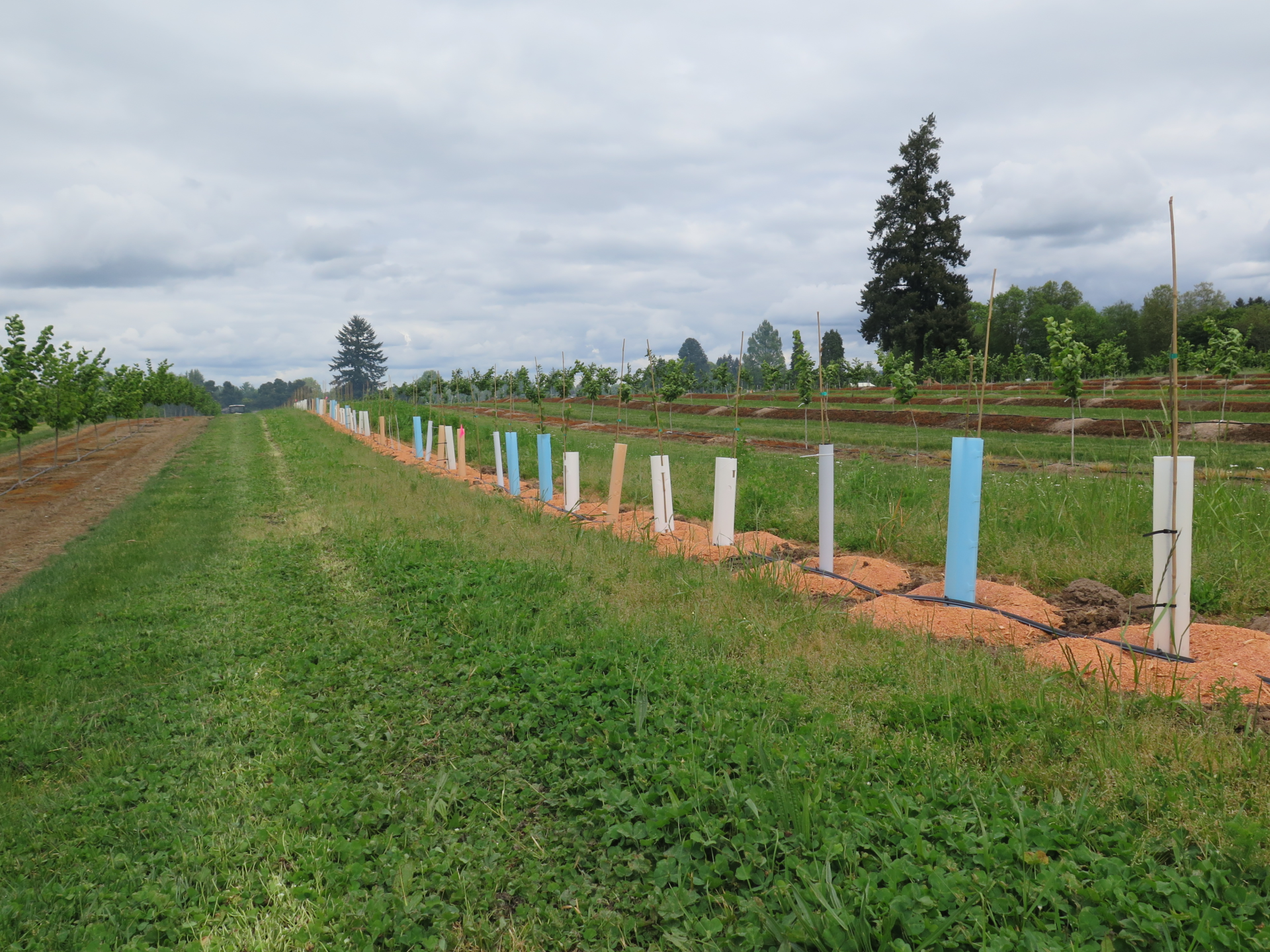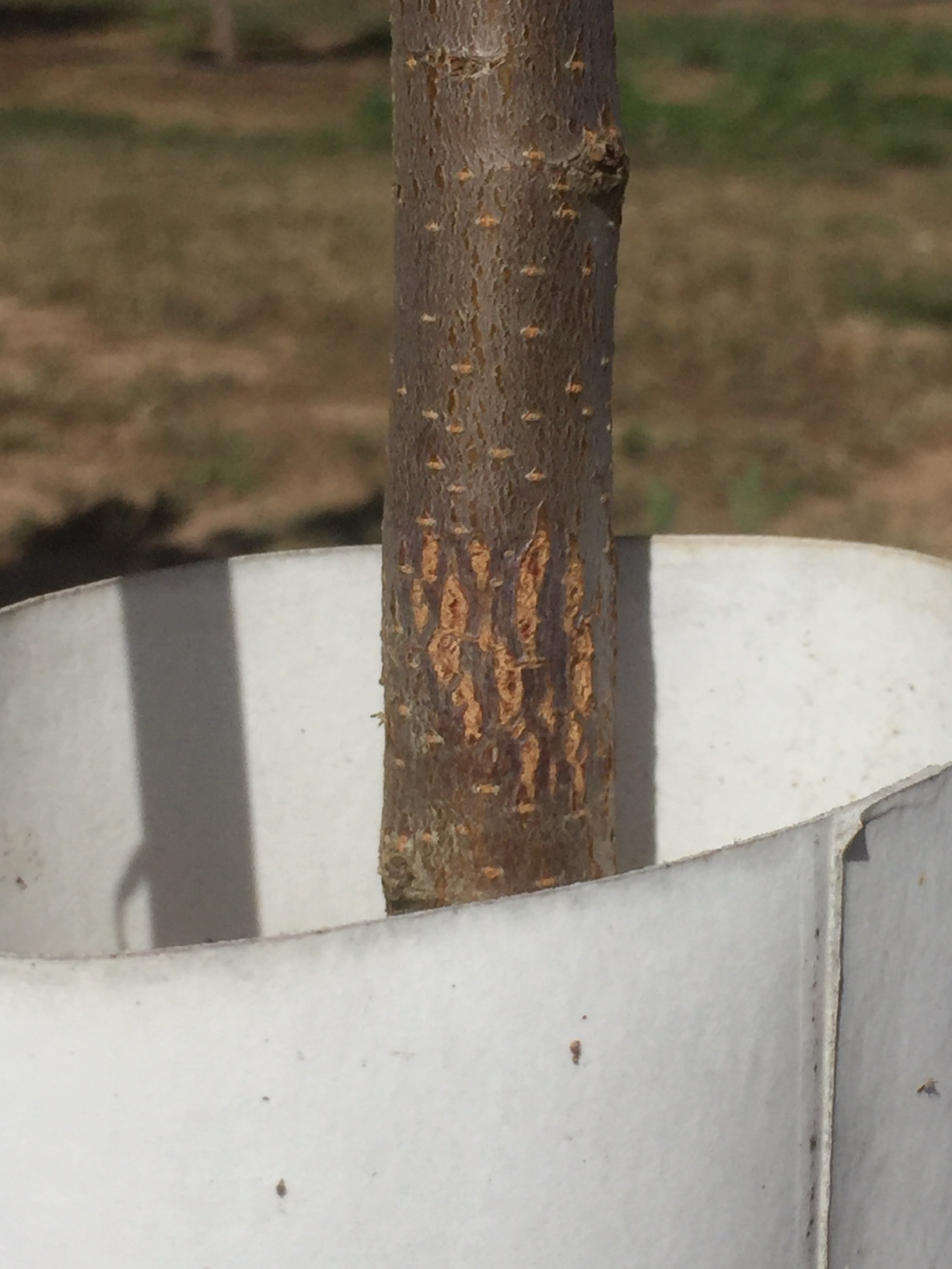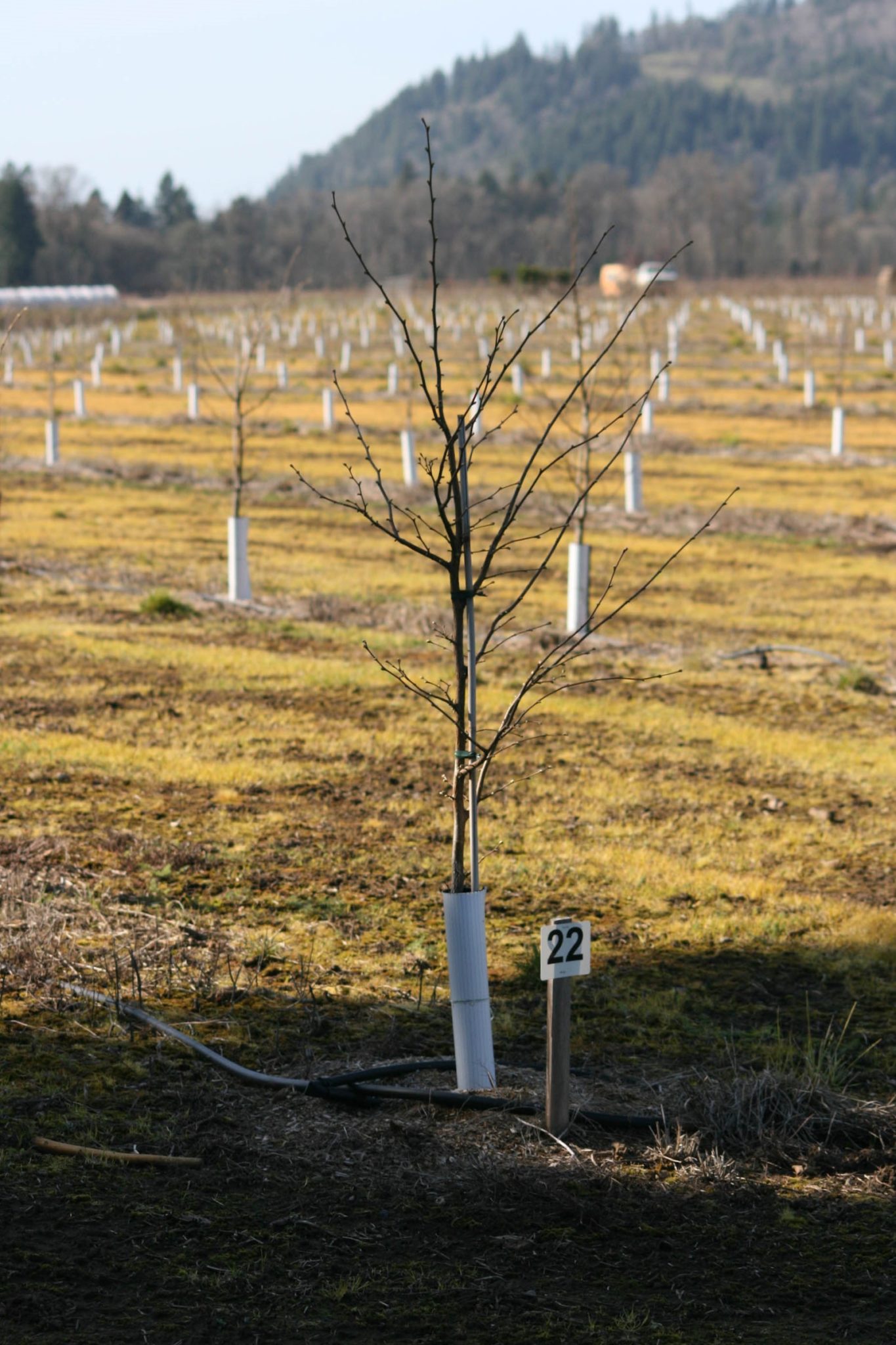New research at the Oregon State University North Willamette Research and Extension Center in Aurora is evaluating sunburn, trunk growth and other effects of trunk guards in new hazelnut plantings. OSU Extension Orchard Specialist Nik Wiman presented findings from the 2018 trial at the Nut Growers Society Winter Meeting, in Corvallis.Hazelnut growers are under pressure to apply trunk guards to young trees to prevent herbicide damage. Wiman’s study produced mixed results and he said the negative consequences of using trunk guards may not be worth the protection and benefits.“I think they cause a lot of problems, but I understand that they give growers peace of mind and may increase spray efficiency for large operations,” Wiman said.“Herbicides can potentially have a negative effect on the bark and health of young trees,” he added. As a result, some herbicide companies want farmers to use trunk guards. They are starting to recommend using trunk guards on their labels. “They want to take away some of that liability,” he said.
Researchers started with bare root Jefferson variety trees planted in two long strips. The 300 trees were planted at 48-inch density. Each was mulched with 5 gallons of sawdust. Five different trunk guard types were randomly installed on 40 trees each with 10 trees left untreated. All trees were irrigated with drip tape. Trunks were measured at 12 inches and stems were headed off at 32 inches.
Trials looked at the following types of trunk guards: Corrugated white and black plastic wraps, paper cartons, blue translucent, peach translucent, clear “grow tubes,” and painted trees.
In addition to sunburn and other trunk damage, and tree growth, researchers measured the number of suckers and water sprouts. They also took a look at how the timing of guard removal affects tree health and growth patterns of young hazelnut trees.
Key Takeaways
Based on Wiman’s research the following pros and cons can be generalized about trunk guards in Northwest hazelnuts:
Trunk Guard Pros:
- Most trunk growth and healthier cambium happen when little to no light is reaching the trunk.
- Water sprout growth is cut by two thirds when opaque trunk guards are used. Paint also reduced the number of water sprouts.
- More opaque trunk guards helped reduce suckering after two seasons.
- Trunk guards help protect bark from herbicide spray.
- Trunk guards help prevent sunburn in young trees.
Trunk Guard Cons:
- Trees can still sunburn at top of the trunk guard. Pacific flathead borer sometimes attacks trees right at the top of the tree guard. “They are attracted to sunburn,” Wiman said.
- Bark under tree guards is tender, so when exposed to sun, it tends to burn easier and is more susceptible to injury.
- Trunk guards are attractive to mice – shelter and food all in one spot. Inside the guards, mice can girdle the tree. They also harbor wasps.
- Water sprouts that do grow under trunk guards are trickier to remove.
- Trunk guards may cause an interaction with trunk diseases including bacterial blight.
- Guards may increase labor costs because they must be opened, lifted or removed to manage suckers.
- Guards can hide problems with borers and rodents.
Water Sprouts and Suckers
“Essentially, we found that when trunk guards let in light, more water sprouts and suckers grow,” Wiman said. “Any treatment that allowed light to touch the bark of trees had more water sprouts.”
Even after the second season, that general trend continued – the more light the trunks received, the more water sprouts.
After one grower season, was no noticeable difference in the number of suckers sprouting from the roots, but significant impact in the number of water sprouts growing from the trunks. The white and black plastic wrap guards showed the fewest water sprouts. The clear grow tubes showed the most water sprouts, followed by the untreated trees. Third most water sprouts came from both the peach and blue translucent guards. Fourth most was the paper cartons, and then the painted trunks.
The water sprouts that grew under the trunk guards created problems making it harder to remove than trees without guards because the sprouts tended to grow closer to the trunk. Removing difficult sprouts growing parallel with the trunks may cause trunk damage. That damage could become infected with pathogens, such as bacterial blight, eventually killing the tree, Wiman said.
Trunk Damage
The bark under trunk guards that let in little light was more tender. So, once the trunk guards were removed, and the bark was suddenly exposed to the elements, it was more susceptible to sunburn and herbicide damage.
“Bark under the trunk guards is sometimes still juvenile,” Wiman said.
The tender bark might also be more susceptible to freeze damage, Wiman noted. Not only hot summer sun can cause sunburn – tender bark could also sunscald in the winter if there’s snow cover on the ground, and the sun reflection is bright and harsh.
Researchers did scrape tests in the spring of 2019 and again in the fall of that year to look at potential sunburn and heat damage to the cambium. Results showed more sunburn damage to untreated trees. Trunk condition appeared best in painted trees and those with the plastic white and black wrap.
Possible cambium damage showed up in all the treatments. Some happened when guards were on, some after removal. The most damage happened to untreated trees.

Tree Growth
Most trunk growth happened with the plastic white and black wrap, followed by paper cartons, then clear, translucent peach, translucent blue, and then painted trees. Least trunk growth was recorded in the untreated control group.
The highest growth rates happened with opaque trunk guards. The white and black plastic wrapped trees outperformed both painted and unpainted trees in growth rate of trunks and canopies.
Researchers rated appearance of canopies, which weren’t affected by trunk treatments.
The temperature inside the tree guards was monitored for two weeks in July 2018. Findings showed that temperatures inside any guards that let in light – clear, peach and blue translucent – were often 20 degrees higher than the outside air temperature. Temps inside the clear “grow tubes” sometimes reached higher than 125 degrees Fahrenheit.
The lowest number of suckers and water sprouts produced over two growing seasons were from the trees with white and black wrap, when those guards were removed in spring of the second leaf.
The worst results, as far as trunk ratings and health, occurred when trunk guards were removed during the first winter.
The last set of trunk guards were removed in the fall of 2019.
In all aspects, unpainted trees did the worst. “I have heard growers say they don’t need to paint, that their bare trees do fine without it,” Wiman said. “But I can say with one-hundred-percent confidence, that their trees would do even better with painted trunks.”
The biggest increase in growth determined by trunk caliper increase was with trunk guards that block the light, especially the white and black wraps. Wiman’s concern with that result is the trunks may be bigger because of a lower density of that hasn’t been put to the test from the environment.
“But with the opaque guards there are less of these undesirable sprouts, and any treatment that reduces suckering and water sprouts is likely to increase growth in the main trunk because of the energy saved,” Wiman said.

Words of Caution
Wiman also points out that farmers can’t see what’s going on under the tree guards. They spend a lot of time opening and closing the guards to check the tree health underneath. “That’s time wasted in my book,” Wiman said.
One farmer went to buy tree guards from the company he’d gotten his last supply from. They were out of the type he’d purchased before, so they sold him clear ones instead. “He lost all those trees,” Wiman said. The clear plastic had a greenhouse effect and overheated the trees.
To stretch money, some growers will cut trunk guards, maybe trying to get two guards for the price of one. Unfortunately, that leaves 6-8 inches of unprotected bark that can sunburn.
Researchers will continue to monitor the trialed trees for at least another year to learn about longer-term effects on bark, tree health and growth. They may also take a look at how hazelnut trees do when planted as a hedgerow.
“We will evaluate trees one to two more times and continue to follow sunburn damage to determine longer-term effect on tree health,” Wiman said in the report.












